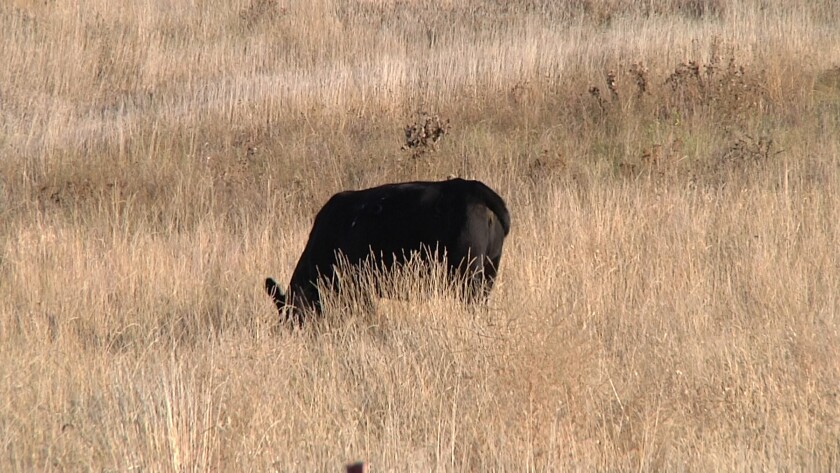CHAMBERLAIN — While the recent shots of rain the surrounding Mitchell area received are improving drought conditions, area agriculture producers could be in for another hot, dry summer, state climatologists say.
During a recent drought monitor meeting in Chamberlain, SDSU Extension Climate Field Specialist Laura Edwards provided farmers with a future outlook on the summer weather that she said predicts this summer “will be a hot one.” And the potential for another drought appears to be a strong possibility based on the climate models, Edwards said.
“We’ve seen some short-term improvements east of the river with the recent rains. Given the wetter and cooler conditions in the Northern Plains, we are looking at a pretty large area of improvement. We’ll see if that holds true,” Edwards said. “But when we look at midsummer — June, July and August — there is a very strong consensus among the climate models and forecasters that this summer will be a hot one.”
Even with the sporadic spring rains, the latest U.S. Drought Monitor that was released on May 12 showed the Mitchell area was experiencing moderate drought, while portions of south central South Dakota were dealing with severe drought. The northeast portion of the state was the only area that remains in drought-free conditions, according to the U.S. Drought Monitor.
The fairly moist, cooler spring paired with the future forecasts showing a hot, moderately dry summer mirrors last year’s weather.
ADVERTISEMENT
For Edwards, the similarities between 2021 and this year’s future forecasts and climate models have given her “nightmares” of another drought potentially on the horizon.
“Last year, it was very cool and somewhat dry in May. Then we turned around really quick in early June with temperatures being 90-plus degrees,” she said, noting June 2021 was the hottest month of June in the state since 1988. “Those two things put together really has me concerned that drought could redevelop or re-intensify this summer despite the moisture we’re seeing now in May. Even with average moisture, heat intensity can still amplify any kind of drought conditions.”
Although Edwards has concerns of another drought looming this summer, she said the National Oceanic and Atmospheric Administration’s (NOAA) future forecast for the month of May that predicts a wetter than average month could lessen the severity of a potential summer drought.
“For May, they have South Dakota pretty much pegged at cooler and wetter than average. It looks like that’s pretty likely to happen,” Edwards said.
The recent steady flow of heavy wind gusts sweeping throughout the state are also amplifying the threat of another potential drought.
“Wind amplifies drought conditions and accelerates evaporation and water in the crops and landscape,” she said.
Minimizing drought impact on the farm
Farming through a drought inevitably cuts into profits, but leaders with SDSU Extension provided a handful of ways producers can minimize the impact.
Heather Gessner, a livestock business management field specialist with SDSU Extension, pointed to baling grasses into hay to be sold and renting some land as a couple options that could provide additional revenue streams in a drought year.
ADVERTISEMENT
“Let’s say I’m short on cows, but need to generate some income. I put together a pasture lease and rent the grass to somebody else,” Gessner said. “We really need to start monitoring our grass and what we have available, and making sure that in good years we are not overstocking our grass and putting additional pressure on the pastures we have.”
Alexander “Sandy” Smart, agriculture and natural resources senior program leader with SDSU Extension, explained how drought impacts grasses that commonly are grown in cattle pastures. Smart said drought always has a lag effect on perennial grasses.
“Even though you get normal precipitation the next year, the bud formations for tillers and shoots happen that previous year. All of the new shoots we’re getting this year, that was all the buds that were formed last summer and fall,” Smart said. “If we have a drought, it will impede how the grass is going to be able to form those buds.”

Gessner said rotating crops and shifting cattle to areas in pastures that received more spurts of rain than others are a few methods that will ultimately improve cattle grazing for livestock producers amid drought conditions.
“If it does start raining a little bit, maybe look at some rotations so we are moving the cows where the grass is growing in the pasture," she said during the group of farmers at the Chamberlain drought monitor meeting. “Let’s say if the wheat didn’t work, we can put in something different to keep the cows off the grass for it to regrow.”
The last piece of advice Gessner emphatically emphasized for farmers to practice is using written agreements that detail how the operations are to be carried out. Gessner noted that South Dakota requires a written agreement for any multiyear lease agreements to be in place.
“Have a written agreement. Memories change,” Gessner said.
Drought, disaster assistance available for SD producers
Jim Anderson, executive director of Farm Service Agency (FSA) for Brule and Buffalo counties, broke down the disaster assistance programs available for farmers who suffer losses from drought and other weather related disasters.
ADVERTISEMENT
With the threat of another potential drought this summer, Anderson highlighted the Livestock Forage Disaster program that compensates livestock producers who have suffered grazing losses due to drought or fires on land that is native or improved pasture land with permanent vegetative cover or specifically planted for grazing.
According to Anderson, all but two counties in the state last summer experienced extreme enough drought conditions for producers in the respective counties to be eligible for the Livestock Forage Disaster program.


